Blue Rewards from Al Futtaim Group Shares Loyalty Success Stories and Evolution. Watch Podcast >
Capillary Triumphs with 4 Prestigious Wins at the 2025 International Loyalty Awards! Read more >
The ultimate guide that covers everything about customer loyalty programs, from the fundamentals to advanced strategies, industry trends, real-world success stories, and more!
Think of the ice cream shop you stop by occasionally, the brand of sneakers you have three pairs of, or the make of your first car which you still recommend to family and friends without hesitation. When a brand is able to create personalized experiences which become cherished memories for the customer, loyalty is realized.
In its simplest sense, customer loyalty is a customer's willingness to repeatedly return to a company to conduct business. It’s what drives customers to choose a brand over a competitor offering similar benefits.
A customer loyalty program is a marketing approach that recognizes and rewards customers for associating with a brand on a recurring basis. A company may dole out points or perks, and graduate customers to higher loyalty levels. These incentives and benefits often result in the customer becoming a more regular consumer and a brand promoter.
Loyalty programs rely on engaging fundamental human behavioral drivers, such as -
Whether you’re promoting coffee sales, ride-hailing services, or credit card usage, loyalty programs are a way for companies to engage with every single customer in their ecosystem.
Traditionally, businesses have considered purchase as the sole indicator of customer loyalty - rewarding repeat purchases and aiming for customer retention. But loyalty initiatives today are built with a complete view of customer activity and their omnichannel interactions with the business. So they recognize customer loyalty in all its expressions (along with sales), and encourage customers to engage actively, earn, and benefit from loyalty rewards.
Most marketing initiatives are effective because they are time-bound. Say, for example, the Black Friday Sale is successful, because it’ll end soon. On the other hand, a loyalty program is effective for exactly the opposite reason. Customers see a loyalty program as a brand’s promise of ongoing association unspoiled by time. This is why customers respond to loyalty programs differently than any other marketing invention.
In an increasingly crowded market, loyalty programs can differentiate you from your competitors and keep your customers around. There truly are endless benefits but let’s consider the essential ones -
Customers make a purchase decision on more than just price. They consider values, engagement, and emotional connection shared with a brand. Customer loyalty programs are a great way to engage with customers beyond the point of purchase and communicate shared values. This means better customer retention and share-of-wallet as customers convert, and spend more time and money with the brands they're loyal to.
Customers make a purchase decision on more than just price. They consider values, engagement, and emotional connection shared with a brand. Customer loyalty programs are a great way to engage with customers beyond the point of purchase and communicate shared values. This means better customer retention and share-of-wallet as customers convert, and spend more time and money with the brands they're loyal to.
Verified online reviews carry a lot of weight for potential customers researching products and services online. Every time a customer shares their experience with your brand on their social media channels, it builds traction. By incentivizing user reviews and ratings as a part of your program, you can invite authentic user-generated content.
Any engagement or personalization is designed using customer data. The more authentic the data, the clearer the insights. There have always been ways to gather first-party data on your customers, but with loyalty membership sign-ups, customers share their data and preferences willingly in exchange for value. So loyalty programs can bring in zero-party data, which is immensely valuable in designing positive customer experiences.
Returning customers are the foundation of nearly every successful business. It’s virtually impossible to operate without them. But what if your returning customers purchased more and more often? That’s what a well-built loyalty program helps accomplish.
Origin of Loyalty Programs - Copper Loyalty Coins (1793)
Supermarkets and gas stations offered ‘copper tokens’ redeemable for in-store merchandise, laying the foundation of loyalty programs.
The Grand Union Tea Company offered tickets exchangeable for goods, boosting customer engagement through value.
The Larkin Company added certificates to soap products, redeemable from catalogs — a hybrid loyalty and sales model.
Milwaukee stores introduced trading stamps that customers collected and redeemed for goods, increasing retention.
Betty Crocker pioneered printed ‘Box Tops’ on packaging, establishing a loyalty mechanism rooted in everyday purchases.
American Airlines launched frequent flyer programs; Discover introduced cashback — changing how loyalty was measured.
Tesco became the first to implement card-based tracking of customer behavior, enabling targeted rewards.
CRM and POS systems powered data-driven loyalty. Amazon Prime offered subscriptions for exclusive perks.
Mobile apps and omnichannel programs emerged. Customers earned rewards across in-store, web, and social platforms.
Loyalty programs have evolved into powerful tools to foster customer engagement, spanning decades of innovation and tech integration.
There are many types of loyalty programs since there are no limitations on your vision for customer experience —especially with modern technology platforms. All programs can be distilled down to the basic process of purchases or actions for earning rewards, but where you go from there is up to you.
What matters most is that your customers find the program’s experience and incentives not just engaging but compelling. Aside from meeting your customer’s expectations, any type of program can be successful.
This is the simplest form of a modern loyalty program, where customers earn points for every transaction or specific action. These points can then be redeemed for discounts, additional merchandise, experiences, memberships or subscriptions for other services. Traditionally, points-based loyalty programs operate on a flat structure—all points have the same value regardless of when the purchase was made or for what, and all customers redeem points for the same selection of rewards.
While tiered programs incentivise customers to spend more or more often, they operate similarly to points-based programs. The difference is that members who accumulate enough points in a given timeframe join a new tier that offers better rewards. What makes tiered-loyalty programs so successful is their ability to effect customer buying behavior. It encourages repeat purchases and is helpful in increasing the average order value (AOV).
Some loyalty programs require an up-front cost to gain access to exclusive deals and opportunities. Such fee-based loyalty programs work by offering relevant value to highly engaged customers - whether it's in the form of free shipping, special discounts or priority access to sales. Having a membership fee also creates a de facto customer segmentation.
Cashback programs are simple and straightforward - for spending X amount, you get Y as cashback. They have been successful in keeping customers for industries like retail, banking and insurance.
Also known as coalition loyalty programs, you partner with other brands to offer rewards and incentives to a shared group of customers. Which company would be a good fit for a partnership? - depends on your customer’s everyday lives, needs, and purchase processes.
When you provide your customers with relevant value that goes beyond what your company alone can offer, you're showing them that you understand and care about their challenges and goals (even those you can't solve alone). Plus, it helps you grow your network to reach your partner’s customers too.
Running a loyalty program involves common costs and varying costs. The price you pay depends on the scale of your program, your specific requirements and how you choose to operate it for your customers. So the varying costs are always case-specific. Let’s consider the common costs for running a successful loyalty program.
This typically requires investing in a technology platform or software to manage the program. The setup cost includes -
The most direct cost of a loyalty program is the rewards themselves, whether they are discounts, free products, exclusive services, or points redeemable. Maintaining sufficient inventory of reward items (particularly if they are physical goods) can add to operational costs. Though taking a larger view, the cost per member and rewards costs should be fairly negligible, especially if the program boosts sales.
Word of mouth and customer-facing staff will help market a loyalty program. But to truly grow a loyalty program, significant investment is required in communicating it to everyone. In the start of the program this means communicating to attract enrollment, which involves costs for promotions and incentives for initial sign-ups. On an on-going basis, you communicate with the members to keep them active, informed about any changes to the program and building engagement.
When you first get started, you and your team may juggle the responsibilities of running a loyalty program alongside other tasks. This can help the team members see how the program can be integrated into other (seemingly unrelated) activities and technologies. We often see marketing, e-commerce, CRM or Customer Success Managers sharing the initial loyalty tasks. As your program starts picking up, it will become essential to have a dedicated team in place, ensuring a smooth loyalty experience for the members, driving member engagement, and maximizing your return on investment.
In sectors with high-frequency customer interactions, the accumulated customer data alone can often justify investment in a loyalty program—particularly as the programs offer ways to monetize the data through highly personalized engagement.
In addition, loyalty programs can help introduce new revenue streams for the business. Remember that -
The software platform is the heart of your loyalty program. And represents the biggest decision you’ll make when setting up your loyalty program - i.e. do you build the platform yourself or purchase and customize a third-party software?
Developing the loyalty software in-house gives you full control over the process, its functionality, and intellectual property (IP) - which guarantees that the end product will reflect your vision. But it also requires a significant amount of time, as you’ll need to figure out everything about designing and running a loyalty program from scratch. You will also need to work with loyalty and CRM experts, strategists, and technology advisors to oversee the build and implementation. And dedicate your internal staff to full-time frontend and backend roles, prioritizing them away from existing projects.
The main benefit of SaaS Loyalty software is that the company behind it has both the knowledge and technology to help you set up and run your loyalty program faster. Since the backend is already set up and ready, you only need to take care of the concept and the front end. This enables you to develop a program that meets your specific budget and requirements. In addition, if you are looking to partner with other brands and build a loyalty ecosystem, the SaaS Loyalty solutions company can put you in touch with other brands, which cater to the same customers as you do.
Gone are the days when loyalty programs were just a marketing tool for driving repeat purchases & promoting customer retention. Loyalty programs today are complete platforms spanning the customer journey end-to-end. And they can help businesses achieve a whole lot (apart from sales)- new customer sign-ups, better engagement, brand advocacy, re-invigorating dormant customers, predicting revenue streams, creating differentiation in competitive markets, and more.
The present-day programs can seamlessly aggregate data from all channels and create a unified customer profile. With this singular and complete understanding of your customer, you can design and deliver hyper-personalized engagements at the right time for maximum impact. So what does it mean to have a successful loyalty program? You decide!
You can begin by asking some key questions to arrive at a relevant KPI -
Answering these questions will help establish a measure for program success, understand loyalty, and what all you can do with it.
So you’ve answered the questions and arrived at exactly what you want from your loyalty program. Here are the key metrics to measure the effectiveness of your customer loyalty program in meeting the set KPI -
Keeping track of your program’s membership is essential to determining how successful the program is. Consider measuring the acquisition and retention performance.
Engaged members are active members. Suppose a large number of customers have joined the program, but few are redeeming the points they earn. Check for the value of promised rewards or consider initiating a marketing campaign to encourage redemptions.
This metric tells you whether program membership incentivizes larger purchases or more frequent purchases. If there's no significant difference between member and non-member spend, consider member-only offers and promotions to boost this metric. This will also improve the Reward Redemption rate.
Although they can lead to a significant sales increase, starting a loyalty program is a considerable investment. Tracking a customer's lifetime value—or how much they'll spend with your brand over time—will help you understand whether you'll achieve positive results and how soon.
Customer Loyalty Index (CLI) is a method for tracking customer loyalty over time. Working with the viewpoint that customer loyalty can’t be summed up in a single number, CLI takes into consideration multiple factors through a questionnaire with three essential points -
Customers answer on a scale of 1 to 6, where 1 means “very likely” and 6 means “not likely.” CLI is the average score of the three responses. Measured periodically, CLI can be effective in tracking customer loyalty. This method reveals an understanding of customer loyalty more than a singular metric approach.
Modern loyalty programs require seamless technology integration across multiple touchpoints. Here are key technologies to consider:
Balancing the value proposition of a loyalty program is no easy task, especially since every customer segment has different preferences. So a problem that loyalty customers often face is that they find it too difficult or feel it takes too long to earn rewards. To avoid this problem -
From messaging to rewards - every aspect of your program should be as personalized as possible for each customer. Personalization is critical to developing the emotional connections that foster customer loyalty. Skipping on personalization and generalizing the experience will leave them disinterested. The same happens if your program does not offer or is unable to highlight ‘members-only’ features. To avoid this problem -
Too many brands have a program where incentives are triggered by transactions only. In addition, these follow-up incentives are all transactional and do little to develop a relationship with the customer. Loyalty members are set apart from non-members by how they feel about your brand and their willingness to engage more deeply. By keeping the bulk of your rewards against transactions, you can end up diluting the member’s loyalty relationship with your brand to a transactional relationship. To avoid this problem -
Discounts have their place in loyalty programs and are great for building a quick response over a short time span. But they are not relevant to building loyalty. Customers who respond to discounts are highly likely to switch brands in the absence of one. In addition, discounts can quickly erode program value, while offering very little scope of reverting back to the original price points. To avoid this problem -
Customer journey is not linear and they’re interacting with the brand across multiple channels. Many customers visit the physical store and research products online before purchasing. So having an omnichannel loyalty platform, enabling your program is a must. If you’re operating a loyalty program with incompatible data inputs from channels that don’t talk to one another, then things will only get harder. To avoid this problem -
Loyalty is an organization-level commitment to the customer and nothing less than that can do. But way too often loyalty programs are treated like a marketing initiative, to be executed by customer servicing, where all the accountability comes to rest.
Let’s say your program promises ‘Seamless returns’ to members.Which is only possible with use of point-of-sale technology, backed by operations and managed by in-store teams that can recognize repeat customers. So you see how each loyalty deliverable spans internal functions. To avoid this problem -
While all your marketing efforts can be layered into your loyalty program, it should be done carefully. Often in attempts to spice up the program, brands add new practices and conditions. And rather than creating excitement, it discourages customers and makes it challenging for them to join the program. Overloading your loyalty program with too many things - social media shares, referral bonus, coupons, discounts, can complicate it. To avoid this problem -
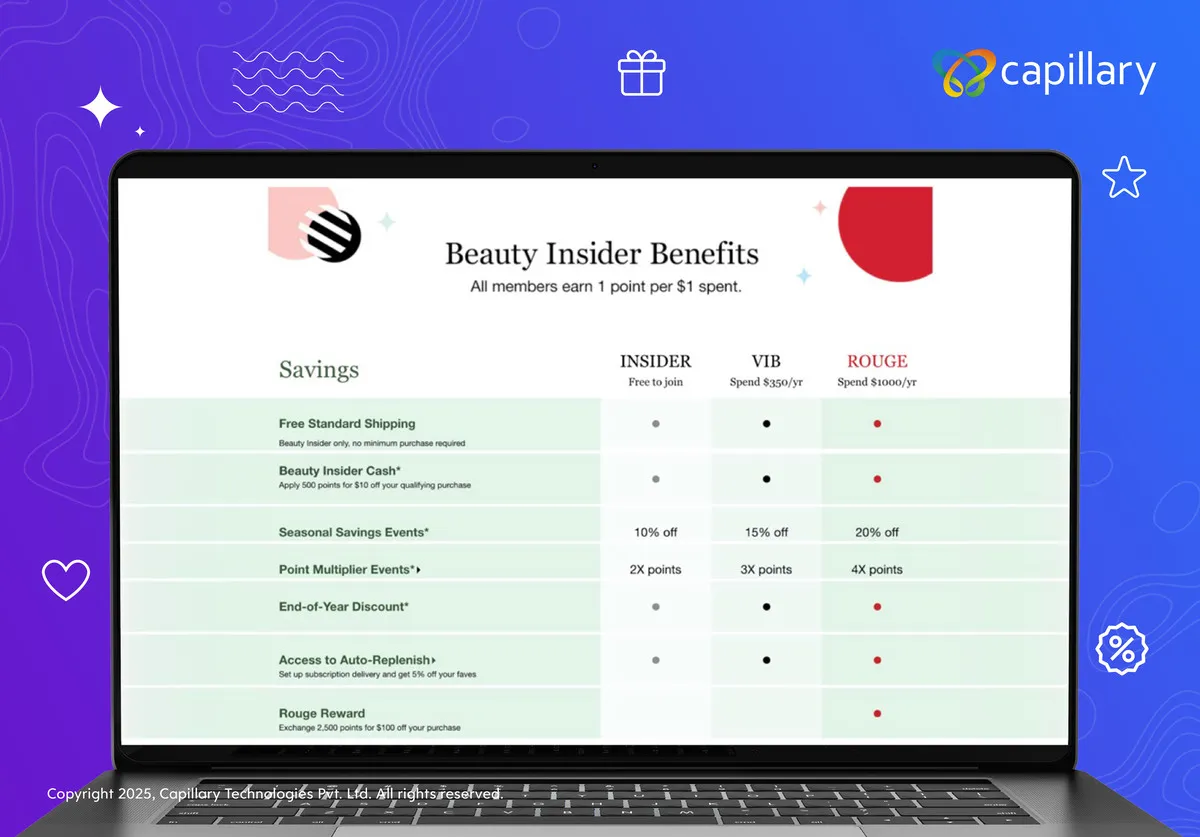
Sephora offers a points-based loyalty program. Customers swipe their Beauty Insider cards at every purchase to track the amount of money they spend. Depending on a customer's average purchase threshold, they're grouped into one of three types of Beauty Insider — these tiers identify the top spenders among the already loyal group of customers.
Every dollar spent earns the member one Beauty Insider point, which shoppers can redeem for beauty products at checkout.
One of the best parts of a Beauty Insider at any tier is the free samples! Being able to try before you buy is very beneficial for skin care and beauty products.
A paid subscription model, Amazon Prime offers free, two-day shipping on millions of products with no minimum purchase. Plus access to Amazon services like Prime Video, Gaming, Reading, Photos and more.
The program delivers such simple and straightforward value to frequent shoppers that the annual payment makes sense. Amazon Prime has been hugely successful, with Prime members spending twice as much as non-Prime members do.
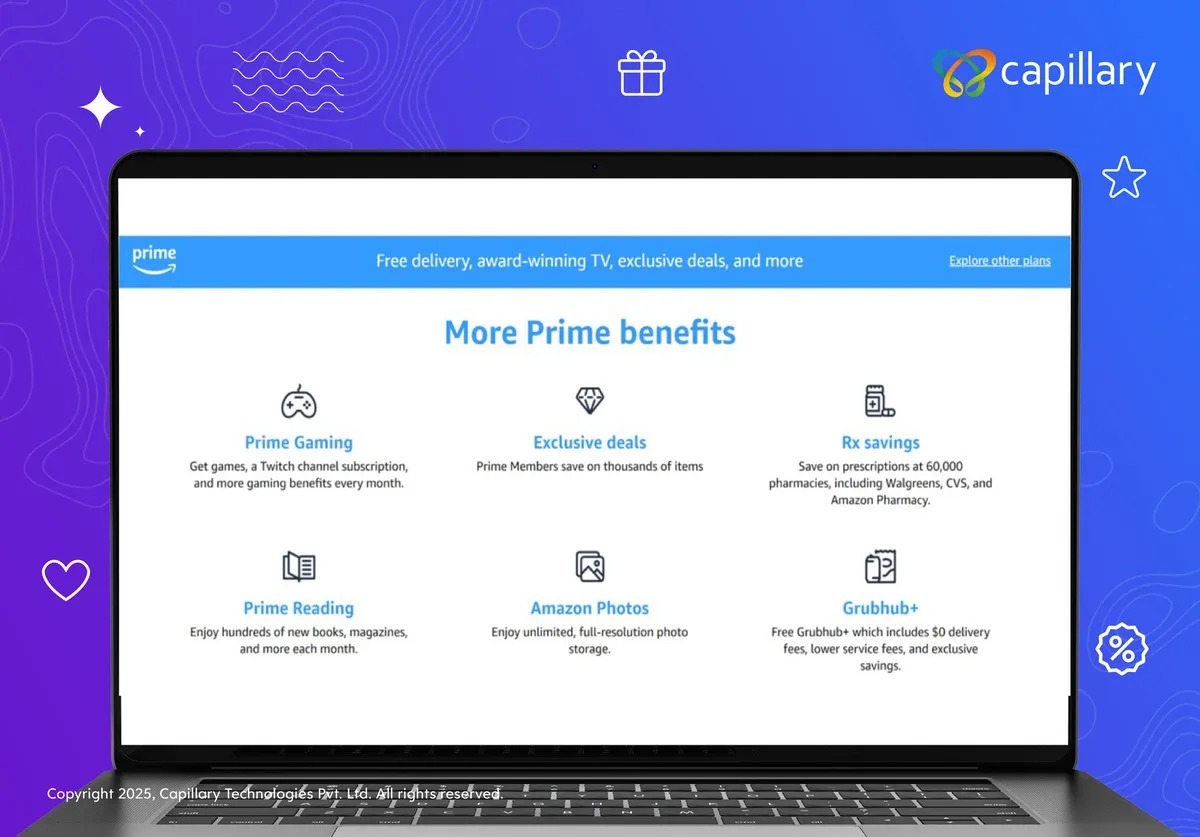
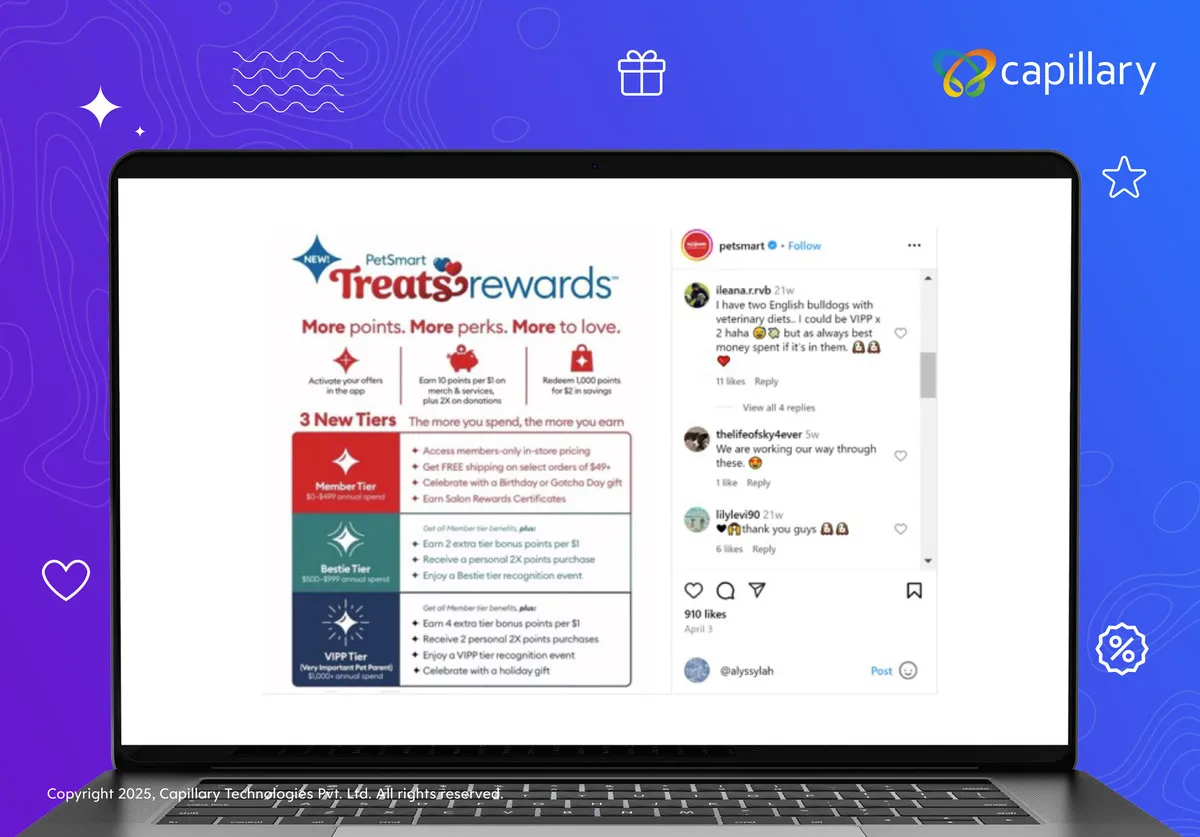
What pet owner doesn't love treating their best friend to delicious food, new toys, a haircut, and more? The PetSmart Treats loyalty program makes this easy for pet owners to do while also saving them money. The beloved pet supplies brand introduced several changes to its program in April 2024 and made it better with -
Pet care can be quite expensive. So being able to collect and use points for activities like grooming, puppy training, and pet hotels offers great value.
The Body Shop believes that business can be a force for good. So their loyalty program makes it easy for customers to gain rewards while having the option to donate. As a member of the Love Your Body Club, customers earn a point for every dollar spent and receive exclusive members-only parties and sneak peeks of new collections.
Points can be redeemed for discounts but also donations to a variety of charities. This solidifies the brand’s image and increases customer engagement and loyalty since customer values are reflected in the program.
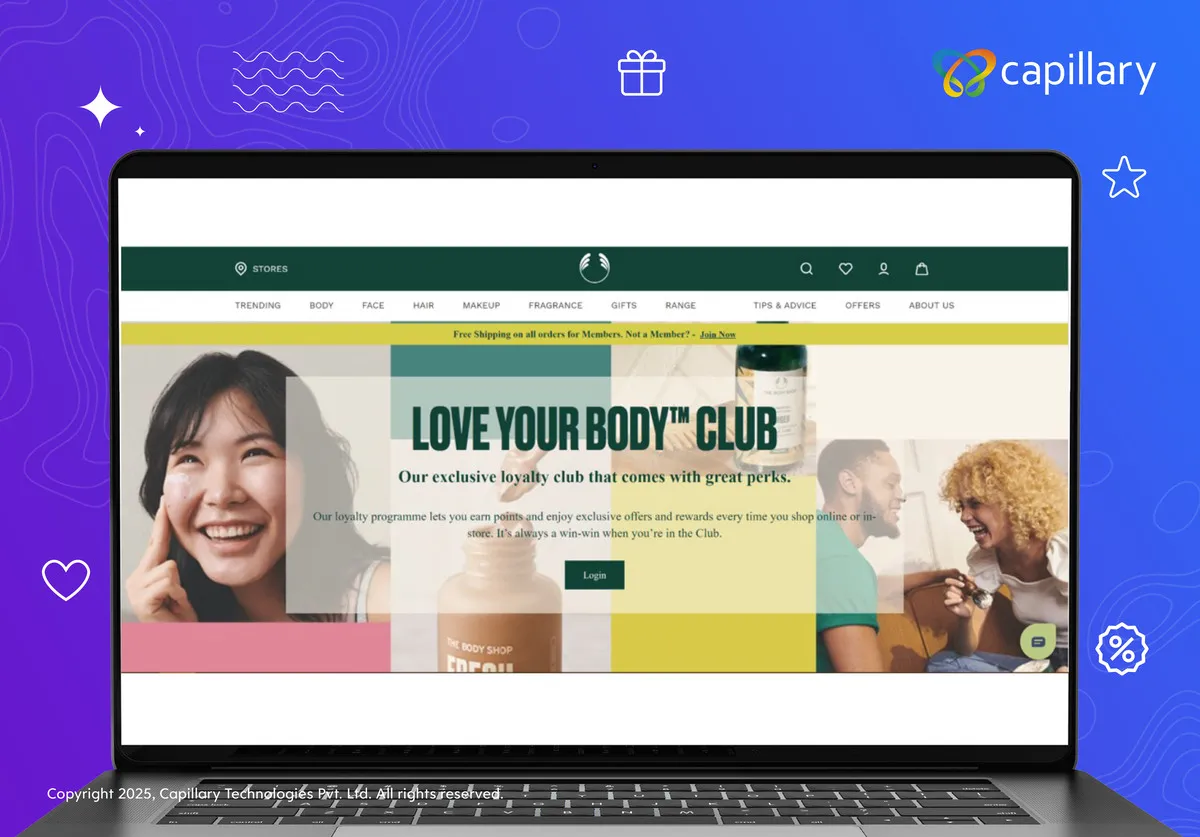
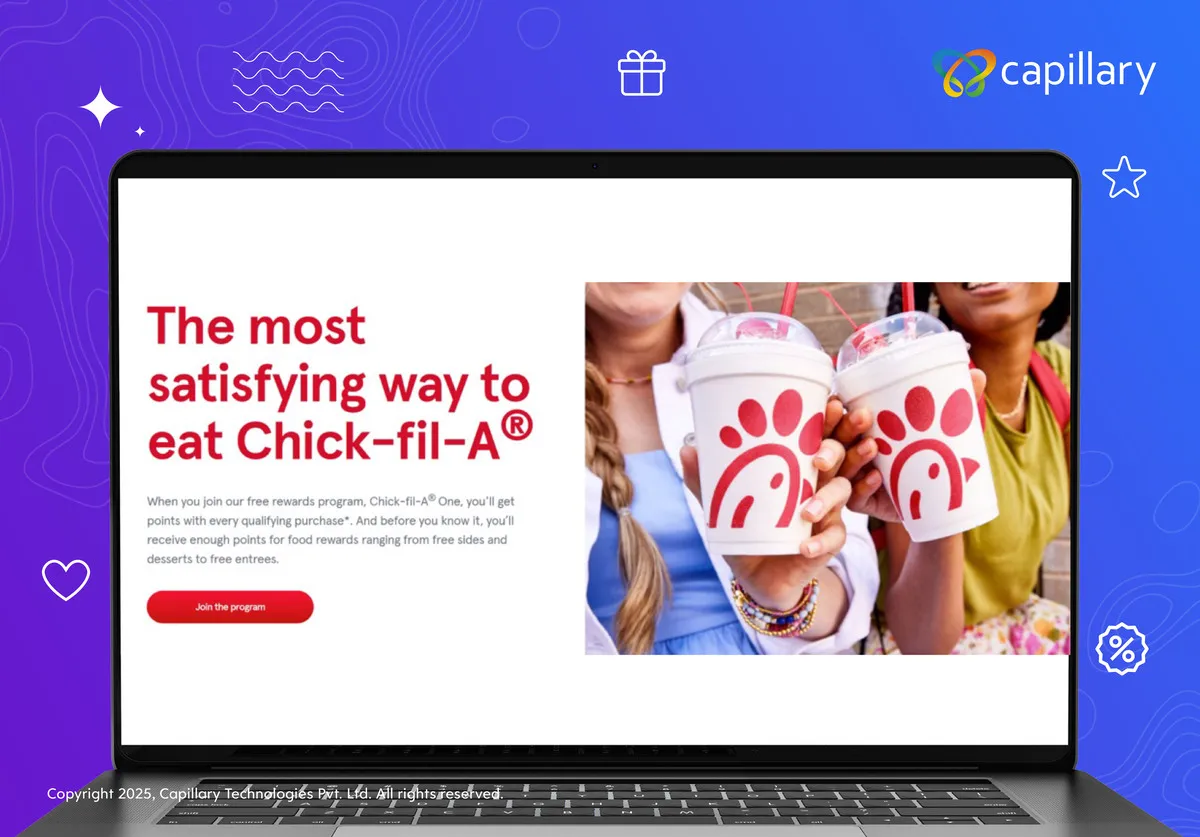
If there’s one quick service restaurant that knows how to rack up the sales, it’s Chick-fil-A with $13.7 billion in system-wide sales in 2020. A big part of their success can be attributed to their loyalty program, Chick-fil-A One, which boasted millions of active users
With its enticing benefits like free treats, convenient drive-thru experiences, and opportunities to gain exclusive rewards, customers keep coming back for more. Chick-fil-A also uses their app to gain insights on customer data and feedback so they can offer an experience that is worthwhile to their customers.
There’s nothing sweeter than an ice cream loyalty program. By signing up for Ben & Jerry’s Flavor Fanatic program, customers can get 10% off every purchase along with extra perks like free cones and insider scoop.
Along with rewards like discounts and free birthday cones, Ben & Jerry’s also advocates for social justice with special flavors like Save Our Swirled! for the global climate movement and I Dough, I Dough for marriage equality.
Not only do they have social justice-themed flavors, but they also donate sales to charities that support the environment, social programs, animal welfare, and other causes.
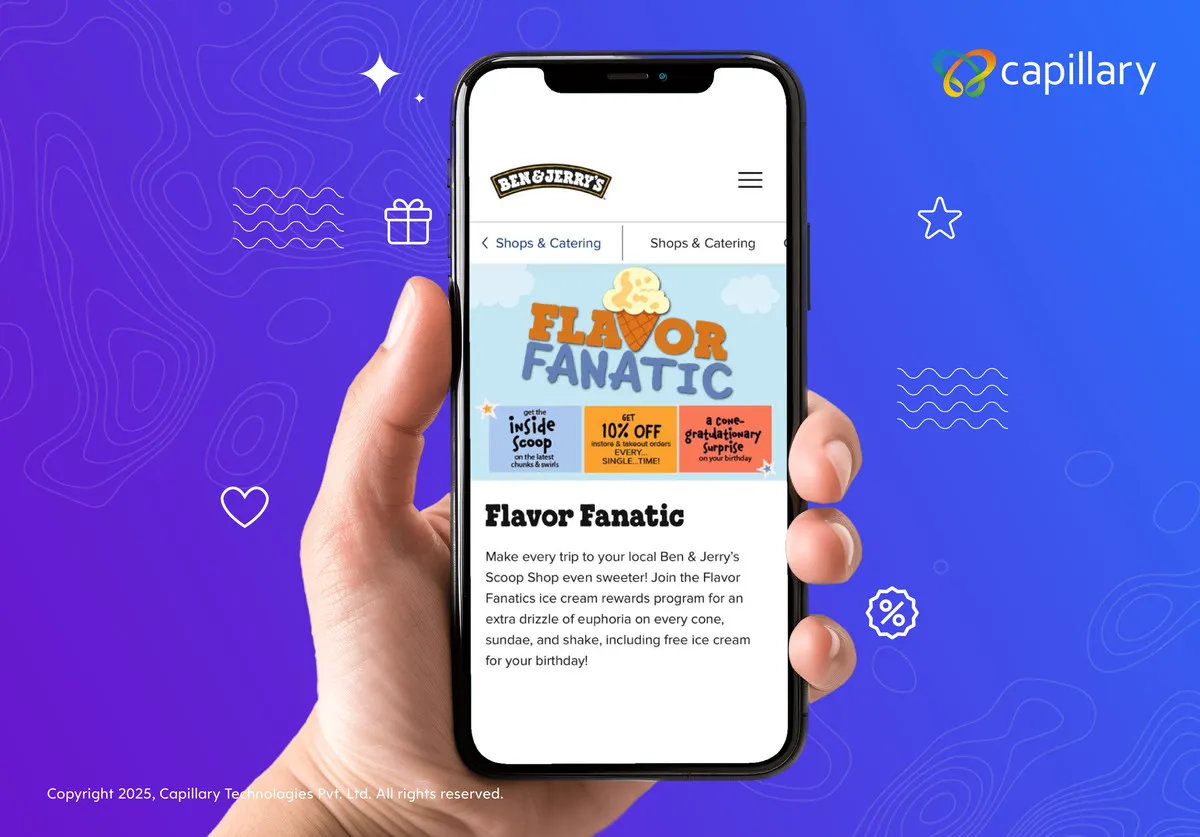
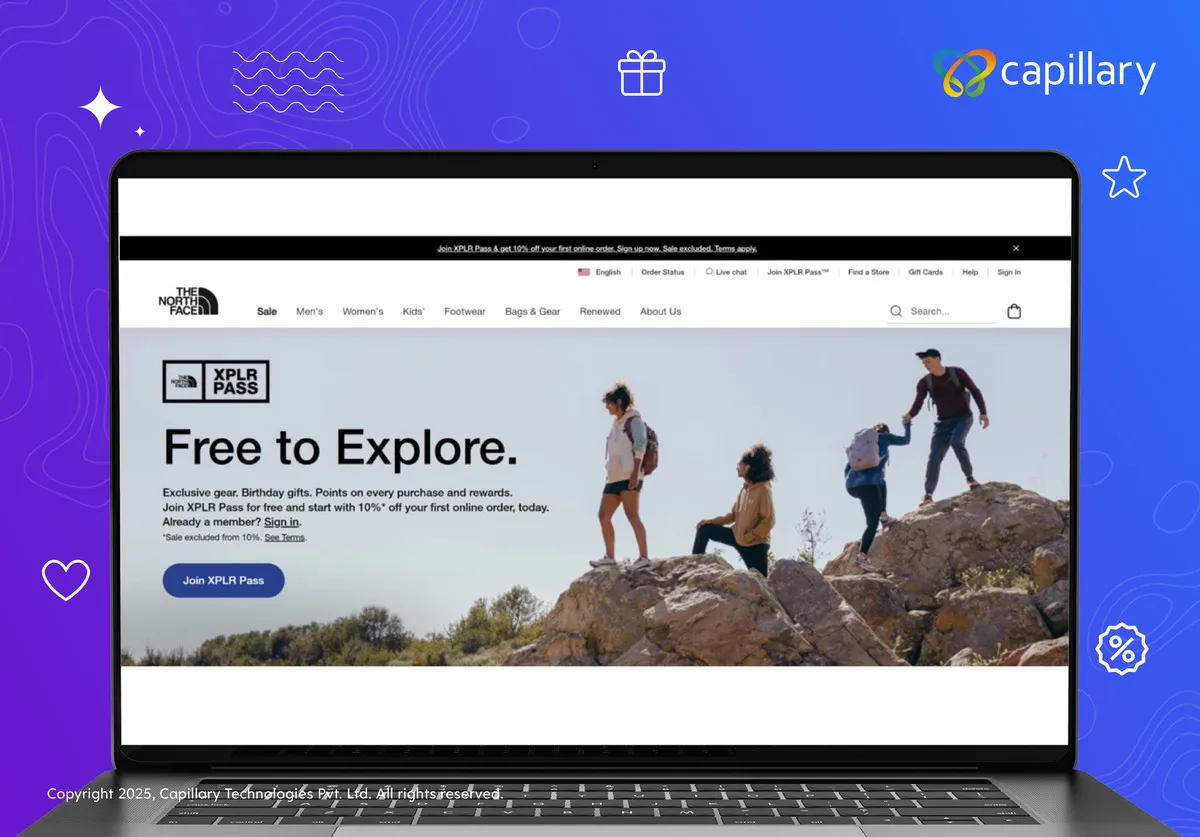
In the outdoor apparel and gear industry, it’s fair to say that most customers value experiences over other forms of incentives
With The North Face XPLR Pass, members can earn points by purchasing merchandise or attending special events - whichever works best for them. Customers can use their points towards unique travel experiences such as a mountain climbing trip in Nepal.
The XPLR Pass also extends an early access to limited-edition collections, exclusive access to products released for members-first, and member-only field testing to allow customers to test products to make sure it’s the right fit for their needs. Rather than offering basic discounts, The North Face curates experiences that speak directly to and build a stronger connection with their customers.
We are in the privacy-first era. Businesses are facing an increasingly complex challenge of collecting and leveraging consumer data without infringing on privacy concerns. While customers demand more personalized interactions, their awareness of privacy concerns also makes them wary of sharing personal information.
The consumer data privacy regulations that have been put in place over the past few years (GDPR, CCPA) have also increased the awareness that not only do businesses have privacy regulations to comply with, but consumers have the right to secure their data.
With data usage and handling becoming a key factor in customer purchase decisions, businesses must invest in privacy and security as an investment towards creating an essential competitive advantage.
A loyalty program can have hundreds of data points on each member. So it is crucial to ensure that data is maintained in a manner that minimizes unwanted intrusion. A good rule of thumb is to treat customer data like you treat inventory. This helps to immediately arrive at the necessary practices for data management – how to gather it, data stocking, establishing data shelf-life and correcting pilferage.
Know what data you are collecting?Before you turn on the data collection initiatives, there must be a clear understanding of
Data minimization approach dictates that enterprises should limit the collection of personal information to what is directly relevant and necessary to accomplish a specified purpose. Look to retain data only for as long as is necessary to fulfill the purpose. To evaluate which data is essential, conduct periodic data audits. Following minimization, enterprises can reduce their sensitive data footprint substantially.
Consider data pseudonymization (as one of the practices recommended by GDPR). It is the processing of personal data in such a way that the data can no longer be attributed to an individual without using additional information.
Say, for example, removing a customer’s first and last name, and replacing it with randomly generated strings. The information is still useful, however, it is nearly impossible to link the identity of a user to this information. This greatly reduces the risk of identifiable information theft in case of data breaches.
Define and implement a clear data privacy policy and communicate it to all stakeholders. The policy should specify who is allowed to access the data and how. It should also clearly state how the data should and shouldn’t be used.
Publish a privacy policy using clear and simple language for customers to read through. The policy should specify how your company collects, stores, uses, and protects customer data. Keep customers informed on any changes that are made to the policy.
Privacy-conscious companies enjoy deeper consumer loyalty, improved ROI and are less reliant on third-party data to make crucial business decisions. Businesses that can factor privacy into their loyalty initiatives will definitely ‘hear back from their customers’ and build long-term trust.
Our guide here covers everything you need to know to get started with building your loyalty program. But do customize your program to improve member participation and stand out in the market. Consider strategies that will help attract new members, retain existing ones, and result in customers promoting their love for your program. Here are five tips to consider once your loyalty program is in progress -
The highest-performing rewards programs are carefully designed to appeal to all customer segments. Identify aspirational top-end rewards that are guaranteed to create an impact with high-value customers as well as easily attainable deals and discounts for new customers and those with a lower lifetime value. In between these two, create a carefully selected range of treats and savings of various values.
Loyal customers come from all backgrounds, with varying degrees of technological literacy. Creating ease of use requires asking questions about how your customers will likely use your app or website. What level of preparation are they likely to have? In what contexts or environments will they be using the interface? Ensure that there are affordances in place that make your interface natural and enjoyable.
With loyalty now being derived from the entire experience someone has with a brand, developing authentic emotional connection with customers is essential. Building your program around people’s needs, values, and preferences will create a personalized loyalty experience and build credibility for the brand.
Customers are increasingly purchasing based on values. Work these values into your rewards program. You can give your customers the option to convert their loyalty points into donations for specific causes or create limited-time promotions that support initiatives. Conduct surveys to understand which causes your customers are passionate about and adapt your program accordingly.
Once you have an active loyalty program and have begun gathering its data, use it to build high-value customer profiles. This will enable you to identify high-value customers, as well as high-value prospective customers who could be recruited profitably. By identifying and understanding your most profitable loyalty customers you can actively look for and convert similar customers.
In the world of customer retention, building a loyalty program stands out as a major endeavor for any company. Loyalty programs can be a game-changer if created with care and deployed with precision. And taking the first step is often the most daunting, with the many decisions to be made around your program.
This is why brands must choose a loyalty service provider based on three things - they should understand emotional connections, gather and decode customer insights, and have strong project orchestration capabilities.

At Capillary, we partner with 400+ global brands to create and deliver comprehensive enterprise loyalty programs for 1 Billion + customers.
With an industry-leading loyalty cloud, Capillary delivers an API-centric, no-code loyalty platform for omnichannel businesses, combined with unique in-store functionalities. Our best-in-class capabilities engage your program members wherever they are - online, in-store, or on the go.
Begin, Build, and Broaden your Loyalty Journey today with Capillary
Know about our pioneering Loyalty Technologies that create memories and moments of delight! Loyalty + | Insights + | Engage + | Rewards + | Capillary CDP +
Contact Us